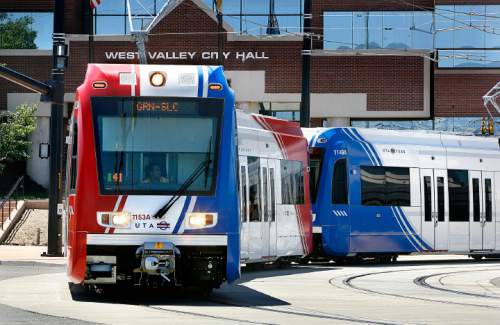This is an archived article that was published on sltrib.com in 2014, and information in the article may be outdated. It is provided only for personal research purposes and may not be reprinted.
Sandy • The groundbreaking for an apartment and office complex rarely would attract U.S. Transportation Secretary Anthony Foxx as its main speaker. But the new East Village development in Sandy did on Monday because officials say it is a first-in-the-nation new breed of government-business partnerships.
It is a "transit-oriented development" where the Utah Transit Authority uses some extra land it had obtained for a rail station to partner with a private developer on a project designed, in part, to increase transit ridership.
Transit-oriented developments around train stations are not new, but they have been all-private enterprises until now. Creating one with a regional transit authority as a financial partner is a first.
"This is an amazing moment, not only for you here in Sandy, but also in the state and in the country," Foxx told a crowd at the Sandy Civic Center TRAX station.
"When you put the money in to build the system, you start to see the private development community come and respond to that through transit-oriented development," he said.
He praised the first-in-the-nation project, coming after UTA recently built six new rail lines over a five-year period. "I've been calling Utah the microwave state because y'all get it done, and get it done fast."
Foxx also pushed for more congressional funding of transportation — which he said generates jobs and economic growth. "I think the biggest challenge this community is going to have is whether we have the resources going forward at the federal level to help get this vision built out."
UTA is donating only the land for the East Village project, which was obtained originally with federal grants, which made the project require federal approval. Hamilton Partners — known for building the 22-story 222 Main tower in downtown Salt Lake City — will do the rest on the $42.6 million project.
Plans call eventually for 1,200 apartments, 300,000 square feet of office space and 30,000 square feet of retail space. The first phase will have 271 apartments, with rents expected to range from $725 to $1,387 a month, said Bruce Bingham, a founding partner with Hamilton Partners.
UTA President and CEO Michael Allegra said the project could help bring a change that regional planners hope will help handle the expected 60 percent population growth along the Wasatch Front by 2040.
Because little vacant land remains to develop, they hope to handle about a third of the coming growth through more dense development around transit stations. Because transit is nearby, residents may need fewer roads and cars, and create less pollution.
"We look to be one of those catalysts for change in this community. We think this going to go and become the norm for our community in the near future," Allegra said.
He noted that when UTA built the Sandy Civic Center station, "We ended up buying more property than needed. Now we can put this property back on the tax rolls, increase our ridership, create a sense of place" with the project.
Allegra said that eventual profits from such partnerships may also allow UTA to expand its service.
Sandy Mayor Tom Dolan said because of growth expected in his city, "Density is going to be part of our future. We either plan for it now, or we get run overrun by that density. And this density is going to be high quality."
UTA has similar transit-oriented projects in process in Clearfield, Farmington, Salt Lake City, South Jordan, South Salt Lake and West Jordan. The Utah Legislature has allowed it to be involved in eight such projects as an experiment.
The new transit-oriented developments sometimes have been controversial for UTA. The agency's management of them was especially criticized last month in a scathing legislative audit.
The audit complained that UTA had allowed sweetheart deals for developer Jeff Vitek, not long after he paid millions to a UTA board member for development rights at a Draper FrontRunner station.
UTA "prepaid" Vitek $10 million for a parking garage at that Draper station, which he never built — UTA hired another contractor to construct it. Vitek has yet to pay back $1.7 million of the $10 million that he was "prepaid," the audit said.
It added that UTA awarded Vitek a contract for a development at the Jordan Valley TRAX station even though its staff complained that Vitek's company did not provide all the required information, which other bidders did.
It said UTA's contract with Vitek at Jordan Valley is "tipped significantly" in his favor, and makes UTA take too much of the financial risks.
The audit also noted that UTA used federal funds to build two large garages at the Jordan Valley station, which have largely sat vacant — but are seen as important eventually to Vitek's development there. Vitek's company has yet to pay its $3.9 million share of that garage project.
UTA has said it is implementing all recommendations made by the audit to improve its oversight.
That includes creating more checks and balances. Instead of allowing UTA's general council's office to solicit, negotiate and rule on legality of contracts with developers, those functions will soon be split with a soon-to-be hired director of transit-oriented developments.



